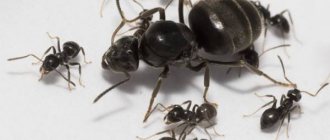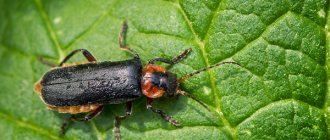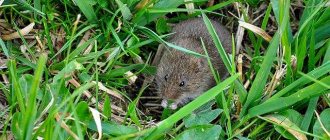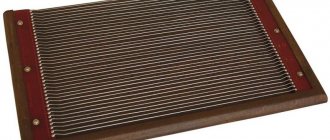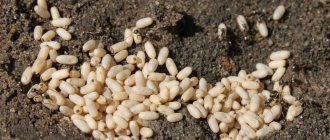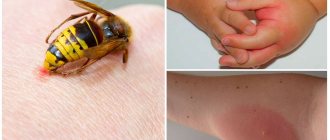general characteristics
The shrew family (Soricidae) belongs to the order of insectivores of the mammalian class. Externally, the shrew is similar to an ordinary mouse , but has a smaller body (from 3.5 to 18 cm long, weighing from 1.2-1.5 to 100-150 grams), with soft fluffy fur of a predominantly gray color and a very long tail. She has small, blind eyes above an elongated muzzle with an elongated proboscis nose and almost invisible ears on her head.
More than 20 species live in Russia, including the ubiquitous common shrew , whose sharp teeth are colored brown due to the presence of iron in the enamel (which explains its name). The body is covered with light brown hair and reaches no more than 8 cm in length and weighs 4-16 grams.
Common shrew (pictured)
From April to September, the female breeds 2-3 offspring, numbering from 4 to 14 cubs, bearing them for 13-28 days. 4 weeks after birth, the animals are ready for independent life, the duration of which is about 18 months.
When a mother shrew moves with her offspring, you can see them holding onto each other's tails with their teeth, as if they were playing "train"
What does a shrew look like? Photo and appearance
The shrew family (Soricidae) includes many species (more than 350), united by common external characteristics and way of life. All of them are united into three subfamilies: shrews (Crocidurinae), shrews (Soricinae) and mouse shrews (Myosoricinae).
Shrews are often confused with mice. The main difference is the elongated muzzle, reminiscent of a movable proboscis. It should be noted that this animal is not a rodent, that is, it has nothing to do with mice. Shrews are distinguished by their extremely small sizes. Representatives of this family are the smallest mammals in the world.
All shrews are distinguished by the presence of the following external features:
- thick short fur;
- very small eyes;
- short limbs with 5 fingers;
- large head.
The color is most often gray or brown. The length of the tail can vary significantly. You can also notice that shrews have greatly enlarged front incisors (this especially applies to the lower teeth).
The animal is not picky about its living conditions, so it is distributed almost all over the world, with the exception of Australia, New Zealand, New Guinea and South America south of Ecuador, Colombia and Venezuela.
The likelihood of this pest appearing on the site increases in the presence of fallen trees and stumps, as well as burrows left by other animals. In rare cases, shrews can take up residence in human buildings.
What does a shrew eat? Lifestyle
Because shrews have a huge metabolic rate, they hunt around the clock. The basis of their diet is insects and earthworms. The favorite treats for shrews are the larvae of mole crickets and chafers. In addition, the animal can eat:
- baby small rodents;
- slugs and snails;
- frogs;
- arachnids;
- lizards
Most species are more active at night. Shrews can occupy the burrows of other animals (most often moles or mice) or dig them themselves. They use fallen leaves and grass for nests. Representatives of the shrew family never live in groups. Each individual has its own territory, the size of which is several tens of square meters.
When searching for prey, the shrew relies on touch and smell. During the day, this animal eats an amount of food that exceeds its own weight by 1.5-2 times. Due to this metabolic rate, small species of shrews die without food in just 7-9 hours. The animal's sleep is short-term and intermittent. It should also be noted that shrews do not hibernate. However, under unfavorable conditions, short-term torpor was observed, accompanied by a decrease in body temperature. Some species are prone to cannibalism.
Species that live near water and lead a semi-aquatic lifestyle are distinguished separately. Also, some shrews, such as the common shrew, short-tailed shrew and water shrew, are among the few venomous mammals. It is necessary to pay attention to the fact that such species do not harm gardens and vegetable gardens.
Features of reproduction
Reproduction occurs 1-2 times a year. In some species up to 3 times a year. Pregnancy lasts from 13 to 28 days. The replacement of baby teeth in cubs occurs during embryonic development. One litter can have from 4 to 14 cubs. A newborn shrew is not covered with hair, and also does not have a developed proboscis. The cubs are completely blind.
The female is responsible for caring for and protecting the offspring. The cubs feed on milk for about 3 weeks. In shrews, mother and offspring move in a chain, holding each other's tails. Shrews are distinguished by the presence of a rare ability, in which in the fall the body size decreases and the skull flattens. With the onset of warmth, the size of the animal, its skull and brain volume increase. The lifespan of a shrew can vary depending on the species and habitat conditions. Most shrews live 1.5 years, extremely rarely - 3 years.
Natural enemies
The main threat to these animals is people and pets. The natural enemies of the shrew are represented mainly by birds of prey. Most often they are hunted:
- owls;
- caresses;
- corvids;
- ferrets.
Shrews are distinguished by the presence of a strong musky odor that repels most predators. It has been noted that cats and dogs most often kill shrews, confusing them with mice. However, they do not eat caught prey. In nature, predators also often refuse such food, hunting shrews only in the absence of other prey.
How to get rid of shrews: the most effective methods of control!
Shrews are terrestrial animals and settle in burrows near bodies of water. Sometimes they choose forests with dense vegetation, and more often garden plots, especially where last year's foliage remains. They live in shallow burrows, but are sometimes ready to live in rotten trees.
As a rule, these animals do not show themselves to humans during the day, and prefer to come out only at night. They respect the boundaries of their own and others' territories while hunting. But if the animals collide in battle, the fight will be deadly. Sometimes they have to fight with lizards for food. Basically, the shrew's diet includes insects, and after they have eaten, they move on to the next area. For a few gardeners, this animal is considered harmless, but others adhere to measures to combat the nimble mammals. Therefore, in this article we will look at how to get rid of shrews on the site, and the most effective methods of control.
What harm does a shrew cause?
This small animal, thanks to its activity, digs long and numerous passages. At the same time, the structure of the soil is disrupted, and the root system of many cultivated plants planted in the garden is damaged. As a result, crop losses are possible, and significant ones at that.
In this regard, when a shrew appears on the site, the owners begin to panic and begin to think about how to get rid of this little pest. Moreover, you need to start fighting them immediately, otherwise a whole colony of shrews may appear on the site.
Before choosing a control method, you should weigh everything, because:
- This animal does more good than harm. Shrews actively destroy many pests inhabiting the area, which bring only harm and no benefit.
- The shrew's favorite food is mole crickets, woodlice, chafers, earthworms, lizards and frogs.
- When holes are constantly dug, it improves the supply of oxygen to the soil.
- The downside is that shrews are quite fertile (up to 40 cubs per litter) and too many burrows leads to a negative result. Therefore, in such conditions, there is too little benefit from this animal, but it interferes with the normal growth of vegetables, cereals and other crops. If shrews dig up the entire garden, then it is unlikely that anything will grow on it.
What kind of pest is this?
The large external resemblance to the field mouse misleads many, however, upon closer inspection, the difference is easy to see, especially since these two outwardly similar animals are not even relatives. The shrew is not a rodent, but an insectivorous mammal.
The head, large in relation to the body, has an elongated skull and a characteristic proboscis, sometimes slightly curved downwards - this is its main “calling card”. Short legs and fur, a long tail - everything else about them looks like a “decent” vole. The fur may be gray or light brown, depending on the variety.
The reasons why they choose this or that area are still unknown. They can either suddenly appear on it or go away for no apparent reason.
Harm and benefit
Summer residents have ambivalent attitudes towards the appearance of shrews. Animals do not eat vegetables, flowers, or lawns. Meanwhile, they cause enormous damage by digging up the ground.
Harm
- damage the roots of crops;
- spoil the appearance of the site;
- beneficial insects - bees, wasps and other pollinators - suffer from them;
- They chew through stems in pursuit of bugs.
Benefit
- destroy insect pests;
- they kill hidden slugs - provocateurs of rot;
- repel many rodents;
- loosen the soil, fertilize and saturate it with oxygen.
Each summer resident determines the harm and benefits caused according to his own views.
Common types
In total, there are about 350 species of these small mammals on the planet, but in our gardens you can most often find two species.
Pygmy shrew
There are names such as shrew and Etruscan little one. The coat color is gray-brown, closer to the gray palette. Very sharp teeth. Compared to other varieties, it is slightly larger in size, up to 7 cm. The tail is covered with sparse, but clearly visible villi.
Wood shrew or common shrew
The most frequent guest of dacha plots, where he comes from the surrounding forests. It is distinguished by a dark brown color with a transition to a lighter color on the abdomen. Grows no more than 5 cm.
It firmly settles into the territory it attracts, arranging nests or occupying empty mole holes. Having become accustomed to a place and being expelled from it, she often returns again, considering it her own patrimony.
Appearance and characteristic habits of shrews
The animal's special characteristics and habits must be studied in order to choose an effective control strategy.
If you look at the photo of the animal, you can see that it is small in size and looks like an ordinary vole mouse. It is distinguished by an elongated nose, slightly curved down. Some species have a small proboscis. The head is larger than that of a mouse. The paws, tail and fur are shorter. There are species that resemble moles.
The reasons why colonies appear in areas are unknown. Most likely, their arrival is associated with the migrations of insects that make up the main diet of animals. Colonies can leave on their own, but you shouldn’t count on it. Sometimes they live in one place for a very long time.
You should look for a way to remove the shrew from the garden when it causes harm. If there are few cultivated plants on the territory with roots that are easily damaged, and the embankments, in the opinion of the owners, do not spoil the view, then there is no point in starting a fight. Colonies can bring not only harm, but also benefit. They actively eliminate harmful insects that destroy crops. Each individual eats twice its own weight per day. The passages improve the quality of the soil, feeding it with oxygen from the inside.
If your favorite flower has withered in the flowerbed for no apparent reason, and a hill has risen in the landscaped garden bed, it’s time to remove the pests. It is not always possible to see them - they rarely crawl to the surface. There are ways to determine who owns the site. This must be done in order to choose the right strategy, because the animal’s habits and diet differ from moles and ordinary rodents. For example, they do not eat roots, but make their way through them. Having discovered that part of the root crop has become the wall of an underground passage, you can be sure that it is not a mole or a mouse. They would have started eating it and would have left much less pulp behind. Another sign is the places of settlement. The animal prefers damp soil near water bodies. He, unlike his brothers, is more attracted to wetlands.
It is difficult to determine the number of individuals - one animal can occupy the entire plot, leaving traces everywhere.
The benefits and harms of the animal
Such a nimble little mammal, like the shrew, spends most of its life in garden plots, digging up the ground or eating harmful and beneficial insects.
It is practically no different from a field mouse, with the exception of an elongated muzzle and a long tail. Since a female shrew can have four litters in one season, their numbers can increase greatly if they are not controlled.
Shrews often use holes left by moles, while tearing up new underground passages. Lawns and flower beds, and often the root system of plants, suffer the most from them. They have a well-developed sense of smell and touch, and they also have, like bats, echolocation.
Their nests are not difficult to find. They will live either in a small burrow or in empty stumps or fallen trees. And to insulate their homes, mammals bring dry grass and leaves there.
Shrews divide their area into a feeding area, which reaches almost 10 m2.
Signs of appearance on the site
All obvious signs that this animal is taking over your garden or lawn completely coincide with the presence of other underground inhabitants - moles, voles, etc. The only exact fact of presence is a specimen seen in person. If you find not only underground passages, but also corroded tubers, you can definitely stop sinning against the shrews and shrews - they don’t eat it.
It often seems that a whole flock of these uninvited guests is operating at the dacha, but in fact it may be the only one, since it prefers a solitary way of living and hunting. Which, however, does not prevent her from bringing up to 14 offspring 1-2 times a year, which will become sexually mature in a month and it is not a fact that they will go far in search of their own territories.
These underground inhabitants settle near bodies of water, in swampy areas, under rotten stumps and other places with high humidity.
Methods of counteraction
Of the methods used today, the most effective can be considered the one that is safest for humans and pets. When there are few animals, then in order to get rid of shrews in a summer cottage, it is advisable to use preventive, physical and folk methods of repelling. If their population increases, which leads to serious crop losses, unfortunately, it will not be possible to do without radical control methods.
Prevention
To prevent the appearance of the pest, preventive work is carried out:
- install a barrier in the form of a fine mesh made of plastic or metal along the perimeter of the garden (to a depth of 1.5 m);
- dig up the land to a depth of 20-25 cm;
- lay a fine metal mesh before sowing lawn grass.
Traditional methods
Various homemade devices for scaring away animals and traps with bait are considered proven and quite effective in use.
To make the simplest mechanical repellers, ordinary household waste is used - tin, plastic or glass jars and bottles.
To remove shrews from the site, experienced gardeners advise:
- dig bottles into the ground at an angle of 45° or wooden sticks with tin or plastic cans on them. Under the influence of wind, a noise or hum arises in them, scaring away the animals;
- plant low-growing marigolds, onions, garlic, mint, lentils, hazel grouse, legumes and other plants that have a persistent aroma around the perimeter of the garden.
To scare away shrews, a pipe with a door that opens only inward is installed in the underground tunnel. Earthworms are placed in it as bait. After the trap is triggered, the animal is taken far beyond the boundaries of the summer cottage.
Physical
The most effective and simplest way to get rid of shrews in the countryside is with ultrasonic devices that affect the animals’ well-developed hearing organs, causing them to feel panic, forcing them to go in search of a quieter home.
"Grad 550 UZ" generates high-volume ultrasound, which has an uneven wave pattern, which prevents pests from becoming accustomed to the action of the device
Ultrasonic devices create sound of a certain frequency, which spreads over approximately 400-500 m2 or more (depending on the modification). For example, the action " Tornado OZV.01" is based on the settings of an electronic timer. A vibrating sound (lasting 10-15 seconds) is heard every 45-50 seconds and, amplifying many times, spreads over an area of up to 1000 m2.
Chemical
This method is the most radical way of pest control and is used when too many holes interfere with the normal growth of vegetables, cereals and other crops, and root crops literally fall into the ground.
These chemicals contain toxic substances that cause paralysis of the respiratory system, causing animals to quickly die.
Rodenticide preparations of domestic and foreign production
Among the most effective pesticides (rodenticides) are:
- "Hunter Antirodent";
- "Nutcracker";
- "Rat Death"
It is important to remember that children, pets and beneficial insects can be harmed by chemicals. When working with pesticides, you must strictly observe safety precautions and not violate the dosage specified in the instructions.
Shrew repellers
Devices that you can build with your own hands or purchase ready-made ones will help you get rid of rodents. The use of repellers is considered the most humane and safe way. Homemade devices are easy to make, but they are less effective than store-bought devices.
Homemade mechanical
To make a repeller you need tin cans or plastic bottles: you get a device like a rattle. Under the influence of wind, the structure will begin to make unpleasant loud sounds.
Instructions for making a mechanical repeller:
- Take a long stick and securely fix it in the ground.
- Place a can or bottle on a stick.
- Place a metal strip in the container, which will increase the noise.
- Place a homemade mechanical repeller where holes are found in the ground in your garden.
A constant unpleasant sound will disturb the rodent. Soon the pest will start looking for a safer and quieter place.
- The first signs of alcoholism
- Causes of chest pain
- Folk remedies for hemorrhoids are the most effective. How to treat hemorrhoids with folk remedies in women and men
Ultrasonic
The device emits waves of certain ranges, creating a force field. The repellers have no effect on domestic animals or humans, but rodents and other small pests panic. The shrew begins to rush around, loses orientation and leaves the hole forever.
Depending on the model, the damage radius of ultrasonic or magnetic resonance devices is 10–20 meters (“Tornado 03B”) or even 1 kilometer (“Antikrot”). Externally, the repeller resembles a nail-shaped photocell. Stick the device into the ground and make sure that the radius of the wave affects the entire area. These models require electrical power from the mains.
DIY shrew traps
A reliable, but labor-intensive and expensive way to combat rodents is to install a mechanical barrier. Conveniently performed at the fence installation stage. Dig a fine-mesh mesh around the perimeter of the site to a depth of 1.2 meters. Leave up to 20 cm of free edge on top. It is unlikely that a pest will dive under such a barrier.
A mousetrap with a pleasant-smelling bait is suitable as a trap for a shrew. It's easy to make a simple design with your own hands.
Options for homemade traps:
- Pipe trap. To make it, take a small diameter pipe and install shutters at both ends. They should close inward. Leave fragrant bait in the trap. As soon as the shrew presses its nose into one of the flaps, the flap will open slightly: the rodent will easily get inside, but will no longer be able to get out.
- Wire trap. Make a spacer, which you then install near the entrance to the hole. As soon as the mouse touches it, the locking mechanism will work. Throw away the caught rodent and install the spacer again. Load the trap until the shrews leave the area.
Some gardeners resort to more radical methods - they install traps near the minks that kill the pest. The device is equipped with sharp rods or knitting needles. When triggered, the trap pierces the rodent's body right through.
Cats will gladly take part in catching a rodent, although they do not eat them because of their specific smell. The best time for hunting is at night, when shrews are busy searching for food.
Preparations and devices for exterminating shrews
If folk remedies turn out to be ineffective, then traps, ultrasonic devices and chemical reagents are used to get rid of moles and shrews.
Traps
The following are used as traps:
- Hollow cylinders. A tunnel trap is a piece of pipe that is closed on both sides with tight flaps. The doors open inward freely, but block outward movement. Bait is placed in the trap and placed inside the active passage. You need to check the tunnel 3-4 times a day. Some devices have a built-in alarm that notifies you when an animal is caught.
- Wire mole traps. Metal traps are a system of a metal lever (clamp), a hook, an input ring, a spring and a guard. To cock the mole trap, you need to hook the clamp with a hook. When moving forward, the pest presses on the guard, and the lowered lever presses it in the input ring. Wire mole traps are installed in pairs, since the direction of travel is unknown.
- Traps. Mole traps of this type can resemble mousetraps or traps for small animals. They have a powerful spring, a lever and sharp jagged edges that injure the animal when trying to free itself.
When installing traps, you need to take into account that the main passages most often run along the perimeter of a fence, foundation, paths or other obstacles. The devices are installed underground through excavated holes. The top of the pit is covered with a layer of earth and turf.
Restraining devices are a fairly humane method of dealing with shrews. After catching it, it is enough to take it 0.8-1.5 km from the site.
Ultrasonic repellers
Ultrasonic repellers emit acoustic waves in a range that disorients rodents and small insectivores. When turned on, pests panic, lose coordination and try to leave the unsafe area as quickly as possible.
How to get rid of shrews on your property using ultrasound:
- position the repeller so that the entire area is within its range of action;
- stick a support into the ground;
- if necessary, connect the device to the electrical network;
- turn on the device (preferably in the evening or at night).
Repellers vary in range and type of power source. Powerful devices are connected to the network, and small ones have a built-in solar battery. In some cases, pests get used to the ultrasound frequency, so when choosing, you should pay attention to models that change the radiation range.
The following device models are most effective against shrews:
- Tornado 03;
- Grad 550 UZ;
- Antikrot;
- Thunder-plus;
- Ecosniper;
- Ecotek;
- Weitech WK-0675.
If there are small pets in the house (hamsters, rabbits, rats, etc.), it is better to avoid using ultrasonic repellers.
Chemicals
The most effective remedies for moles and shrews are:
- Mole Meter G. The product has a low danger, since its main component is garlic extract. When placed in burrows it has a repellent effect. To drive away pests, you need to bury odorous granules in holes or vertical cuts near holes and central passages. The consumption rate is 5-7 g for each hole. For prevention, the drug is laid out around the perimeter of the fence.
- STOP-Mole. The drug is available in the form of tablets that quickly evaporate, turning into a poisonous gas. The chemical fills numerous passages, driving out the shrew. To fill evenly, place 2-3 tablets in each hole. You need to lay out the drug with gloves and only in dry weather.
- Nutcracker. It is a thick dough-like bait, which is laid out near the main habitats. The consumption rate of the drug is 1 packet for every 20 m. The death of pests occurs after 3-4 days.
- Rat death. An inexpensive product that is poured into passages and holes. One package is enough to treat an area of 8-10 acres. After eating the bait, the animal dies within 4-8 days.
- Hunter. Available in the form of granules that contain poison and bait. The drug is poured into holes or applied to the top layer of soil at the rate of 10-30 g per 1 sq.m. The death of the pest occurs within a week.
It is best to destroy moles and shrews with chemicals in calm, dry weather and in the absence of domestic animals. If baits are swallowed by pets, contact your veterinarian immediately.
Ready-made products
Ultrasound devices
These are electronic repellers that create high-frequency vibrations. Examples include “Tornado”, “Electrocat”, “Antikrot”, “Typhoon”. You will need a model for open areas. Devices designed for indoor use will not be suitable.
A person does not hear ultrasound. It causes panic in animals, so the device is unlikely to be suitable for owners of cats and dogs.
The body resembles a nail with a pointed leg inserted into the ground and a head. Models differ in power and power supply method. The coverage area and the strength of the impact depend on the power. The louder the sound, the better. The devices are powered by mains and battery. There are repellers that change frequency so that pests do not have time to get used to the wave effect. It will be possible to achieve the desired effect only after a few days.
Mousetraps and traps
They are designed specifically for rodents. Cats and dogs will not get caught in them. Traps are immersed in a hole or placed throughout the territory. Insects and earthworms serve as bait.
Chemicals
- Gas bombs - release gas that causes death to animals. They are thrown into the hole and the entrance is covered with earth so that the gas does not escape out, but spreads throughout the labyrinth.
- Drugs with toxic substances - the victim eats them and dies. An example is “Hunter Anti-Rodent” or “Nutcracker”.
They cause death from suffocation and internal bleeding. They should be used only as a last resort, when other solutions do not help, and it is impossible to save the crop in any other way. It should be remembered that the packages must be stored in a place inaccessible to children and pets. It is dangerous to leave them in an area where the packaging could be found by a child or pet. The products destroy all pests within their field of action.
- Material prepared by: Artem Filimonov
Chemical control agents
Toxic substances are used to kill shrews only when other methods do not help, and there are a lot of rodents. Stores sell different formulations that will get rid of pests in a short time.
Effective chemicals:
- " The Nutcracker". Thick dough-like mass of green color. Place the product near the shrew's burrows and wait until the rodent eats the bait. After 3-4 days, the pests will begin to die.
- "Hunter Antirodent". Food bait (rounded, hard, red granules). Consumption of the drug per 1 ha is 1–3 kg. The bait is laid out on the area where the shrew has settled. The product attracts rodents, which die from suffocation after consuming poisonous granules.
- " Rat Death" The bait has a doughy consistency. The drug is placed near the burrows of rodents, which, after eating the bait, die from internal bleeding and suffocation.
Some summer residents use poisonous gas bombs to drive shrews away from their property. The device is lowered into the hole: the destructive gas spreads through the tunnels, poisoning the rodents.
Video
Experienced gardeners share educational information about the life activity of shrews and ways to repel these insectivores in the following videos:
About the author:
Lyudmila Polyakova Her main specialty is an accountant, so even at her summer cottage she strives for accuracy and achieving ideal order in everything. Preference is given to growing grapes. I am sure that the deeper you delve into gardening and gardening, the more you understand that there is no limit to perfection!
Found a mistake? Select the text with the mouse and click:
Ctrl + Enter
Did you know that: In small Denmark, any piece of land is a very expensive pleasure. Therefore, local gardeners have adapted to growing fresh vegetables in buckets, large bags, and foam boxes filled with a special earthen mixture. Such agrotechnical methods make it possible to obtain a harvest even at home.
Convenient Android applications have been developed to help gardeners and gardeners. First of all, these are sowing (lunar, flower, etc.) calendars, thematic magazines, and collections of useful tips. With their help, you can choose a day favorable for planting each type of plant, determine the timing of their ripening and harvest on time.
You need to collect medicinal flowers and inflorescences at the very beginning of the flowering period, when the content of nutrients in them is highest. Flowers are supposed to be picked by hand, tearing off the rough stalks. Dry the collected flowers and herbs, scattered in a thin layer, in a cool room at natural temperature without access to direct sunlight.
Both humus and compost are rightfully the basis of organic farming. Their presence in the soil significantly increases the yield and improves the taste of vegetables and fruits. They are very similar in properties and appearance, but they should not be confused. Humus is rotted manure or bird droppings. Compost is rotted organic remains of various origins (spoiled food from the kitchen, tops, weeds, thin twigs). Humus is considered a higher quality fertilizer; compost is more accessible.
Natural toxins are found in many plants; Those grown in gardens and vegetable gardens are no exception. Thus, the seeds of apples, apricots, and peaches contain hydrocyanic acid, and the tops and peels of unripe nightshades (potatoes, eggplants, tomatoes) contain solanine. But do not be afraid: their number is too small.
A new product from American developers is the Tertill robot, which weeds weeds in the garden. The device was invented under the leadership of John Downes (creator of the robot vacuum cleaner) and works autonomously in all weather conditions, moving over uneven surfaces on wheels. At the same time, it cuts off all plants below 3 cm with the built-in trimmer.
Oklahoma farmer Carl Burns developed an unusual variety of multi-colored corn called Rainbow Corn. The grains on each cob are of different colors and shades: brown, pink, purple, blue, green, etc. This result was achieved through many years of selecting the most colored ordinary varieties and crossing them.
Compost is rotted organic remains of various origins. How to do it? They put everything in a heap, hole or large box: kitchen scraps, tops of garden crops, weeds cut before flowering, thin twigs. All this is layered with phosphate rock, sometimes straw, earth or peat. (Some summer residents add special composting accelerators.) Cover with film. During the process of overheating, the pile is periodically turned or pierced to bring in fresh air. Typically, compost “ripens” for 2 years, but with modern additives it can be ready in one summer season.
It is believed that some vegetables and fruits (cucumbers, stem celery, all varieties of cabbage, peppers, apples) have “negative calorie content,” that is, more calories are consumed during digestion than they contain. In fact, only 10-20% of the calories received from food are consumed in the digestive process.
Review of popular brands
Manufacturers offer various remedies for moles and shrews on the site: tablets, poisonous baits, ultrasonic repellers. The most popular of them are:
"Dakfosal"
The fumigation insecticide begins to emit heavy gas upon contact with the soil, spreading throughout all passages, penetrating into hard-to-reach places. Two to three tablets are placed at maximum depth. The hole is filled with earth.
DETIA
DETIA with essential oils, safe for people and soil, but effective against moles. The balls are buried at a distance from each other in the hole. Poisonous toxins immediately begin to evaporate. To achieve results, the procedure must be repeated at least 2 times per season.
"Russian Trap"
Bait in the form of paraffin briquettes is used to expel shrews, moles, rats, and mice from a summer cottage. Contains: active brodifacoum and fragrances with a suffocating effect.
ARGUS (gel)
One tube (30 g) is sufficient to distribute at the entrance to each burrow. The active substance is brodifacoum. Causes paralysis.
"Alphos Krot"
An effective drug against moles, hamsters, and gophers. It releases alphos (heavy gas), which gradually displaces air, settling to a soil depth of 3–4 m. The drug will not leave behind new mole spots after 7–10 days. Animals will become afraid and leave the area. For use:
- scatter around the area, throw into holes;
- sprinkle with earth.
The result can be observed within 20 hours after use.
The tablets are used according to the instructions. Do not open the packaging indoors.
"Stop the Mole"
A toxic chemical with migratory properties that quickly fills burrows. 2-3 tablets are placed in each hole and covered with earth. It is better to carry out procedures during the day (from 12:00 to 16:00). Predators immediately leave the dug up areas.
Reference! It is not recommended to throw tablets into holes after rain, or to inhale the gas released.
"Green House Antikrot"
Poisonous gel concentrate is a poison against shrews and moles in a summer cottage. Contains active bromadiolone. One treatment with placing 15 grams into a mole hole is enough, and the desired result will not take long to arrive.
"Antrokot" is a good remedy with a long-lasting effect and is affordable. Eliminates entire populations of rats, mice, moles. Although, according to the instructions, you have to breed the bait yourself.
Additional tips and tricks
- Rodents love to explore places with dense vegetation: ponds or swamps, where there is always water. They often penetrate through underground labyrinths into greenhouses in the spring, which is something gardeners should take into account.
- In 3 hours, shrews can eat as much food as the animal itself weighs. And after 7-8 hours they feel deadly hunger.
- Shrews do not hibernate, but do reduce the amount of food they eat. From spring (April-June) the body parameters are increased again to their previous values.
- Traps and homemade devices for scaring away animals are simple and effective ways of fighting. To help - plastic, tin cans and bottles, dug into the ground at an angle of 45° or placed on a wooden peg. The wind will sway, and the noise and rumble will scare away the animals.
- Moles and shrews do not like the smell of some plants. It is recommended to plant garlic, mint, and lentils along the perimeter of the garden.
- The popular method of fighting moles is to install a pipe with a door in an underground tunnel with the door slightly open inward. Place earthworms as bait. When the plug works, the animal can be taken far beyond the dacha.
- Ultrasonic devices affect the hearing organs of animals. The buzzing makes them panic.
- When using domestic and foreign chemicals, we must not forget that these are poisons. It is important to follow safety precautions and not exceed the dosage specified in the instructions.
10 best ways to remove moles from your summer cottage
To obtain good harvests, it is important for summer residents to systematically carry out work to protect the territory. If you choose the optimal method, you can get rid of moles, mole rats and shrews in your summer cottage in a short time. It is worth acting as soon as moves appear. If rodents take over large areas and create entire labyrinths underground, then it will be much more difficult to drive them out.
How to deal with shrews in the garden: mechanical barrier
Fine mesh rodent mesh
This is a fairly effective method of fighting shrews. However, it involves labor intensity and significant financial investments. It also acts as an excellent preventative against other pests (moles, mole crickets and voles). It is necessary to dig a fine-mesh mesh throughout the entire territory to a depth of 1.2 m. About 15 cm of free edge should be left on top. Uninvited guests are unlikely to be able to get under the device.
Traditional methods of fighting shrews
There are many proven home methods for controlling rodents. Of course, they cannot be called quite effective, but they are suitable as a temporary measure.
Pouring water
Some gardeners and summer residents use this method of fighting shrews. They simply fill the rodent burrows with water. But since the animals are quite small, and they may have a large number of burrows underground, this method cannot be called effective.
Filling mole holes with water
They are effective only if there are several rodents on the site and their exact locations are known. Of course, shooting such animals with a gun or sending poisonous gas into a hole is also not effective.
Deep digging
Sometimes, to combat shrews, they can use the method of deep digging of the area. This method is considered labor-intensive, but quite effective. But you shouldn’t think that the animals will leave the site for good.
Deep digging of mole holes
But reducing their number is quite possible. Once they find themselves homeless, they will want to leave the area in search of another place. But this does not always happen and new minks can be seen in the garden.
Unpleasant smell
Shrews have an excellent sense of smell and do not like the smell of rotten fish. Thus, pieces of fish can be spread around the area, deepening them into burrows. You can use fishmeal as fertilizer.
Place the material soaked in these compounds in the burrows. Of course, a 100% guarantee cannot be achieved, since shrews can make new workarounds for themselves and bypass the bait.
Fish flour
Are you earning enough?
Check if this applies to you:
- there is enough money from paycheck to paycheck;
- the salary is only enough for rent and food;
- debts and loans take away everything that is obtained with great difficulty;
- all promotions go to someone else;
- you are sure that you are paid too little at work.
Perhaps your money has been damaged. Read this amulet here to help relieve lack of money.
Source of the article: https://domdo.ru/parazity/kak-izbavitsya-ot-zemleroek-na-uchastke-samyj-ehffektivnyj-sposob.html
Video tip: how to drive shrews out of your area
Sources
- https://seloveselo.ru/pest/ne-sem-tak-ponadkusyvayu-kak-borotsya-s-zemlerojkoj-na-sadovom-uchastke.html
- https://felisov.ru/tarakany/zemlerojkovye-kroty.html
- https://tehno-gid.net/pest/zemlerojka-vrag-ili-drug-stoit-li-izbavlyatsya-ot-zemlerojki-i-kak-eto-sdelat.html
- https://GdeKlop.ru/kroty/metody-borby-na-uchastke/
- https://ogorodum.ru/kak-izbavitsja-ot-zemleroek-na-uchastke-samyj-jeffektivnyj-sposob.html
- https://apest.ru/kroty/kak-izbavitsya-ot-krotov/borba-s-krotami-i-zemlerojkami-na-sadovom-uchastke/
- https://7ogorod.ru/prochee/sposoby-borby-s-krotami-i-zemlerojkami-na-sadovom-uchastke.html
- https://naogorode.net/kak-borotsya-s-zemlerojkami-na-sadovom-uchastke/
- https://sovets.net/21322-kak-izbavitsa-ot-zemlerojki.html
- https://VrediteliSOS.ru/sadovyie/kak-izbavitsya-ot-krotov.html
- https://www.ivd.ru/stroitelstvo-i-remont/dacnyj-ucastok/kak-borotsya-s-zemlerojkoj-na-dachnom-uchastke-10-sposobov-59531
